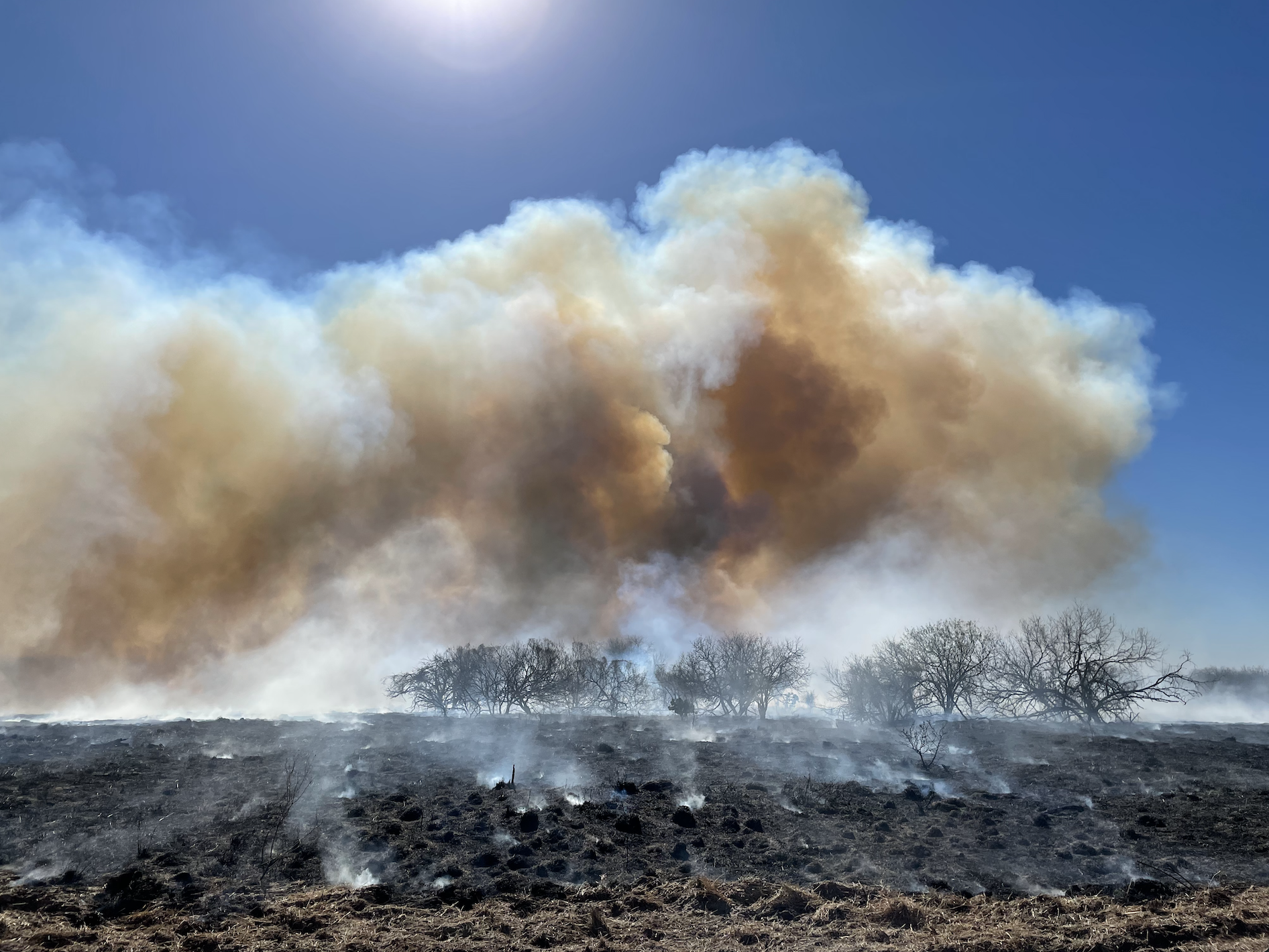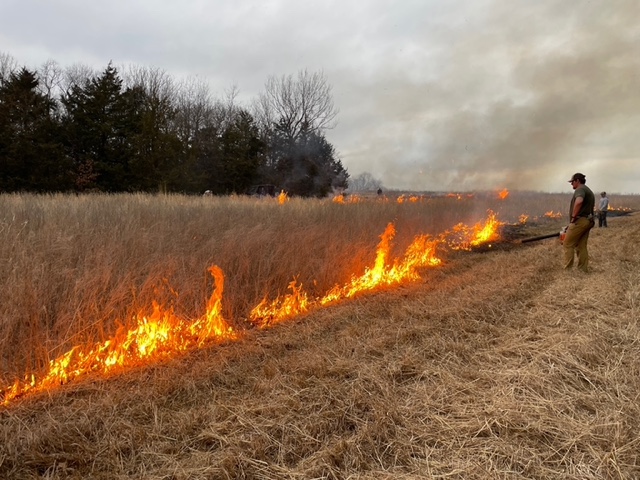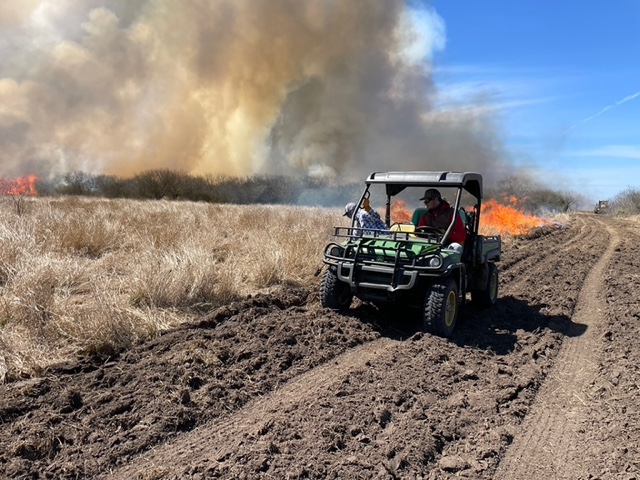By: Rob Grainger, Sales Associate


Chances are, if you are enjoying a bluebird day drive in late winter with a moderate breeze, you are going to see smoke on the horizon somewhere. You may worry or even call the local volunteer fire department to alert them of potential danger, but it’s most likely a rancher carrying out a planned prescribed fire. I have extensively studied fire ecology and have found the use of prescribed fire to be one of the essential tools to manage the habitat on the properties we take care of across the country. When used appropriately on ranchlands, fire will be your friend. You will save years of trying to keep up with invasive species, and your CPA may even thank you for not having to rent equipment or buy so many chemicals.
When fire was first born of a lightning strike from the sky eons ago, the planet’s habitat began to be sculpted. It was clean and organized in a macro sort of fashion. Vast amounts of acreage would burn in late winter or on a hot, dry summer, only stopped by the rivers the fires came across. The Native Americans pioneered prescribed fire a long time ago in North America to keep their landscapes clean, neat, and fresh for the wild game they hunted. Since then, we have manipulated their system into a manageable form to maintain smaller areas.
Prescribed fire has a number of practical uses: maintaining a healthy grassland or woodland, setting back the encroachment of invasive or unwanted species, cleaning up unused dry matter, and revitalizing a late succession habitat, to name a few. A grassland is precisely what it sounds like— an area where a nearly continuous cover of grasses dominates the vegetation. Although the grass will continue to grow each year, if unused by grazers, the dormant grass will lay over and create a barrier that will suppress the growth of the new shoots when the grass comes out of its dormant state. Fire will clean up this dry matter, release and redistribute plant-available nutrients back into the soil profile, and make it possible for the young plants to reach maturity again. The same goes for woodlands. The underbrush, leaf litter, and dry grasses do not allow the timber to utilize everything available to it. Another scenario we are facing more often is the encroachment of invasive or undesirable species. If used at the right time, fire can slow the spread of the problem species or even stop them, depending upon the available fuel loads, the temperature of the burn, soil types, and several other conditions and techniques.
There are two specific types of burns, cool season and warm season. Both have their place, and both can help you achieve your goals. Ordinarily, when a cool-season fire is prescribed and planned, its purpose is to maintain the habitat on a specific property. We are not always trying to kill or restart a plant community but more often keeping a site clean and devoid of encroachment by unwanted plant species. Every year during the winter months, the warm-season grasses and a majority of the woody species go dormant and may defoliate. This is the most appropriate time to clean the site of all dry matter that will otherwise take up space that could be used in the spring when these warm-season grasses and forbs begin to grow. The dry fuel of the site will help carry the fire across the burn unit, and with appropriate conditions, cleanly restore the once unavailable nutrients to the soils and the roots of the plants you just burned. Although cool-season burns can get quite hot if the humidity is low and the wind and fuel loads are high, these burns rarely kill plants. Especially woody plant species. The most favorable conditions for conducting a cool-season burn involve low humidity and moderate winds. We are typically looking for humidity levels from 20%-40% and wind speeds from 8-15 mph. If the humidity is below 20% and wind speeds are above 15 mph, the ignition rate can get too high and create a lot of danger with fire jumping the fireguards.
On the other hand, humidity of 40% and wind speeds below eight mph will not carry the fire and will make it creep too slowly and usually put itself out. We primarily look for wind directions with north in them, as this will bring in the drier air masses, lowering our humidity. Cool-season fires are applicable whether you are a cattleman or wildlife enthusiast. With fawns, chicks, and poults all hitting the ground in the spring and summer, they need all the fresh growth and clean understory they can get. Imagine a quail chick, standing some 1”-3” in height, trying to run through a wad of tangled dead grass. It doesn’t work. They need clean game paths through the grass community, just as does need clean, healthy stands of grass to hide their fawns. Cool-season burns are excellent for cleaning up and maintaining a ranch, while warm-season burns are excellent for other reasons.
Warm-season burns are a sight to behold if the conditions on the range and in the air get right. They are extremely hot, aggressive, and can be pretty dangerous. But, if applied appropriately and safely, they help you achieve an entirely different goal: taking back what was taken from you. Often on ranches with tighter soils or when habitat maintenance has been deferred, woody species and invasive plants will take over a once healthy plant community. If it is not too far gone and in need of mechanical or chemical treatment, a hot summer burn can work wonders to get the range headed back in the right direction. The timing of a warm-season burn is everything, and a lot of conditions must line up. The site will need to have grown ample fuel loads during the spring and early summer to carry the fire well. If you have the fuel loads, you can begin to watch the weather. For these burns to work, grasses need to dry out and cure enough to burn well. We also need hot days with the correct amount of wind to carry the fire and hit the woody plants with enough heat to kill the crown. If the grasses have cured, we want to look for humidity in the 40%-60% range, and wind speeds 8-15 mph. Often we have southerly breezes during the summer months, but occasionally we will get a northerly blow, and that is when our humidity will get right. Some summers do not allow for a warm-season burn, but they can recoup years of lost habitat when they do.
The landscape across the country has changed so much over the years. The immense grass prairies and great plains are not as grassy and great as they used to be. The amazing forests of the East and the West are not quite as clean, or they potentially burned away due to a lack of forest management. We are using prescribed fire less and less, and a large portion of the country’s original habitat is changing because of it. As the original habitat management tool, fire should not be feared but rather should be something all landowners and habitat managers understand and utilize when appropriate. It can truly change your landscape for the better.


